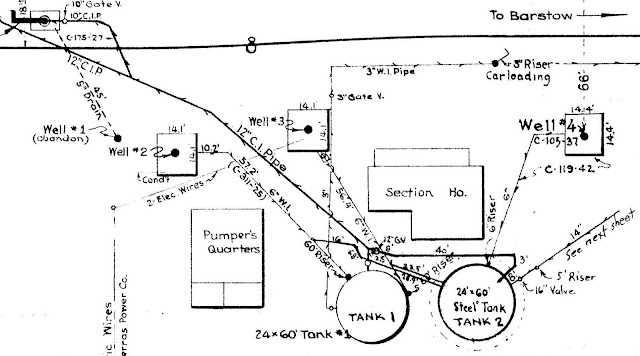Our Victorville locomotives this time are the Santa Fe's EMD freight FTs with no red stripe, a catwhisker paint scheme that began appearing in 1948, peaked in 1951, and then was gone by 1954.
My layout progress was minimal, with one new staging track added and one new control panel design improved, but my helpers made progress on some models of Victorville buildings.
Let's begin with some photos of the Santa Fe's FTs in the catwhisker paint scheme and no red stripe, which replaced the previous scheme that had a partial red stripe on only the cab.
Here's a color shot of FT set #146 at Redondo Jct. in April, 1951, thanks to Fred Scott:
Donald Duke got a shot of FT set #109 with an eastbound Green Fruit Express by the Alray Tunnels (note that in black & white photos shot at a distance, it's hard to be sure that there is no red stripe on the cab):
Here's a westbound freight behind FT set #152 at Lenwood, shot by Fred Hust in Feb. 1948, when the no-red-stripe scheme was still new:
Jack Whitmeyer got a shot of a two-unit FT set (used as helpers on Cajon Pass) on the turntable at San Bernardino:
Here we see two of the two-unit FT helper sets, led by #411, pushing on the rear of an eastbound freight as it rounds Sullivan's Curve (this is a Santa Fe photo):
We've seen this next photo before, when we were looking at the all-blue FT paint scheme that began appearing in 1951 (#151 on the right), but now we're looking at the no-red-stripe FT helper set on the left, pushing backwards on the rear of an eastbound freight at Summit, as shot by Stan Kistler in June, 1952:
Here is FT helper set #198 helping 4-8-4 #2905 with an eastbound passenger train at Pine Lodge in June, 1950, as shot by Richard Steinheimer:
Finally, here is Stan Kistler's July, 1953 photo of FT A-B-A set #125 leading a westbound freight at Frost (just after leaving Victorville) in a power move, with passenger F7 set #340 and freight FT set #149 (this is late in the life of the no-red-stripe scheme):
The next FT paint scheme, beginning in 1954, was the "cigar band" scheme (also used on freight F3s, F7s, and F9s), but the FTs were gone from Cajon Pass before this scheme appeared, so I don't model these. Here is set #127 at an unidentified location in the mid-1950s, just for comparison:
I only know of two models of the FTs with catwhiskers and no red stripe. One is the Stewart FT set in that scheme, as seen here:
The other was the expensive Division Point brass set (which I don't have), detailed for helper and road switcher service:
Now it's time for another layout progress report, but most of the progress was made by my helpers.
I did complete the construction of the new Track E4, which leads to the future cassette-loading area, by filing down loose ties and sliding them under all the rail joiners, and then by adding a rerailer section to the end of the track where the cassettes will dock.
The results are not very exciting to see, but here is the new spot where cassettes will load rolling stock on and off the layout someday, using the rerailer track to keep the wheels on the track:
The major revision to the panel was the addition of the turnout leading to Track E4 (the cassette loading track), which used to be on the Reversing Tower panel, but which really belongs here. Don Borden then improved upon my design and sent me this revised drawing:
I sent for a set of four wooden frames for 8.5" x 11" sheets, and when they arrived, Don wanted to see what the panel drawing would look like when framed, so I sent him this photo:Meanwhile, Kevin Hunter has shipped the Touch Toggles and other parts needed to run the C Tower, so I can see how they all will fit on the back of the panel when they arrive. My printer doesn't produce an image that is exactly the same size as what Don has drawn for me, so we are working on that problem.
My very helpful friend in Victorville, Craig Wisch, is beginning to work on adding the short wooden posts (about 36" long by 12" in diameter) that stick out near the tops of the walls of the control house of the switching station in the Lower Narrows, as seen in this photo:
He's also planning to add some rooftop vents, as seen in some aerial photos, so he picked out an HO set he liked and I sent for them, but they are coming from Australia.
I asked Craig to send us a photo of himself, posing with some of this cardstock models, and here is the photo he sent, with his HO control house on the bottom, a building in London in the middle, and his small Victorville jail on top:
Meanwhile, my friend Bill Messecar has been building one of the two Victorville water tanks from the kits I gave him.
And another local friend, Don Hubbard, has finished adding the vehicles and gas station attendants and other HO people to his model of the Texaco station that stood in the Lower Narrows during my time period. Here's his photo of the front side:
And here's a nice view of the left side:
Don did a great job with this, and I'm sure it will add a lot of interest to that corner of the layout!
I
need to get back to work on the layout in the coming weeks, especially
with getting all the wiring completed for the two mainline tracks,
including the control panels needed to operate them.





































